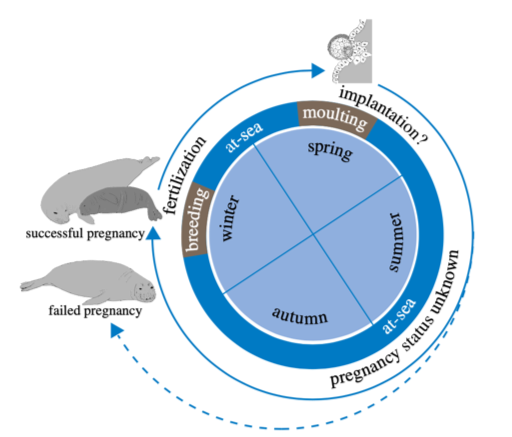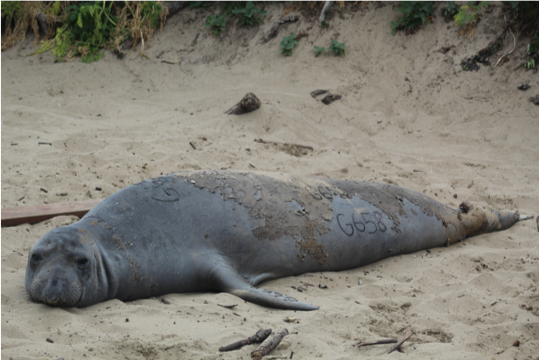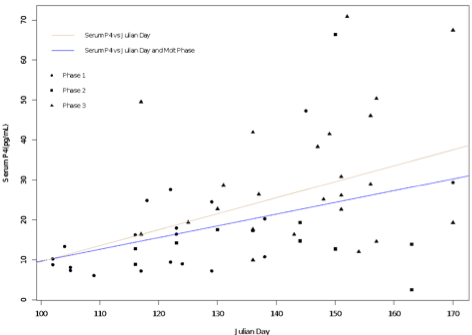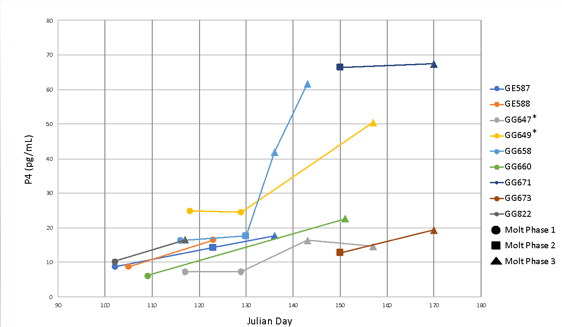Introduction

Fig. 1: Annual pregnancy cycle of elephant
seals.
Northern elephant seals were once thought to be extinct due to commercial sealing in the 1800s; populations in the U.S and Mexico were all originally derived from a few hundred individuals surviving in Mexico and have begun to steadily increase starting from the early 1900s. To understand population dynamics in an effort to promote conservation, we must understand elephant seal pregnancy. Most species of marine mammals undergo pregnancy while swimming at sea, making the study of this critical phase in their life histories difficult. While it is well documented that pinnipeds (seals, sea lions, and walruses) often delay embryo implantation (i.e. embryonic diapause), it is still undetermined when the fertilized egg implants in many species; in other words, when the pregnancy begins. The pregnancy status of these animals can only be confirmed when they return to land, yet it remains unknown whether females that return to land without a pup were initially pregnant or if they lost their fetus at sea, hindering our ability to understand how the environment determines pregnancy success, and thus affects changes in population size. I studied the pregnancy of wild ranging northern elephant seals (Mirounga angustirostris).
 Delayed implantation occurs when a fertilized egg remains inside the mother for an extended period of time, without developing further or dividing. Embryonic diapause appears to be an adaptation to allow females time to find favorable environmental conditions that would support the pregnancy and the upcoming offspring. Because hormones regulate cell division in embryos, one way to assess the onset of delayed implantation is through the analysis of reproductive hormones. Progesterone (P4), especially, can be used to indicate the onset of female pregnancy. In my research, I created the first comprehensive dataset of temporal variations in P4 concentrations to investigate when pregnancy officially begins in northern elephant seals.
Delayed implantation occurs when a fertilized egg remains inside the mother for an extended period of time, without developing further or dividing. Embryonic diapause appears to be an adaptation to allow females time to find favorable environmental conditions that would support the pregnancy and the upcoming offspring. Because hormones regulate cell division in embryos, one way to assess the onset of delayed implantation is through the analysis of reproductive hormones. Progesterone (P4), especially, can be used to indicate the onset of female pregnancy. In my research, I created the first comprehensive dataset of temporal variations in P4 concentrations to investigate when pregnancy officially begins in northern elephant seals.
I conducted my research at the northern elephant seal colony at Año Nuevo State Park, San Mateo County, California, U.S.A. The colony includes approximately two miles of mainland beaches in addition to a small nearby island and has been studied continuously for nearly six decades. Samples were collected throughout the duration of the molt haul out of spring 2019. Using P4 radioimmunoassays (RIA), I quantified the serum P4 concentrations in combination with observations of seals sighted with pups.
Results

Fig 2: Linear regression analysis of serum P4,
Julian Day and Molt Phase.
Of the 41 individuals sampled, 27 were observed with pups the following breeding season. Six were seen during the breeding season, but were never observed with a pup and had a much lower observed P4 concentration (13.96 ± 10.98 pg/mL vs. 26.41 ± 16.59 pg/mL in the 27 with pups). Five individuals were not re-sighted the following season (P4: 26.33 ± 12.28 pg/mL) and may have bred at different colonies. Three were observed on shore prior to the breeding season, indicating that they did not carry a pregnancy to term or may never have implanted (P4: 18.80 ± 10.45 pg/mL). We found that late molt females were much more likely to have implanted, as high P4 concentrations correlated with phase 3 (late molt) females. However, we also saw high P4 concentrations in phase 1 (early molt) females, suggesting there is another driving force for implantation other than molting phase (Fig. 2).
By sampling nine females multiple times across the molting season, I observed how increases in P4 concentration corresponded with different implantation times. I found that only the females with confirmed concentrations of P4 above 35 pg/mL successfully gave birth the following breeding season (Fig. 3).
Discussion

Fig 3: Progesterone changes in seals over time during
the haul out.
I observed an average increase in P4 concentration throughout the molt for all females, which is consistent with what has been observed during ovulation and pregnancy in other mammals. I also found that there is a strong relationship between P4 concentration and molt phase, indicating that as females progress in molt status, so does the likelihood of implantation. While this data suggests that late molt females are much more likely to have implanted, I also saw early molt females with high serum P4 concentrations, indicative of implantation. Likely it is more complicated than simply later molt increases the chances of implantation. I found a strong relationship between serum P4 versus the interaction between Julian day and molt phase, which suggests that annual cycles also play a role in the implantation process.
By tracing P4 concentration over time we observed four major natural history events: successful implantation then reproduction (seals G658 and G671); implantation then failed pregnancy (seal G649); and finally no implantation (seal G647). Given this information, I concluded that a P4 concentration greater than 35 pg/mL indicates implantation has occurred. Our results highlight the diversity of outcomes in elephant seal pregnancy, and the ability of P4 concentrations during haul outs to measure embryo implantation.
I would like to thank Drs. Dan Costa and Luis Huckstadt as well as my PhD student mentors Logan Pallin and Rachel Holser for mentoring me throughout my research. I would also like to thank the Norris Center as well as the Seymour Marine Discovery Center for funding my research. All work and photographs were carried out under NMFS permit 23188.
